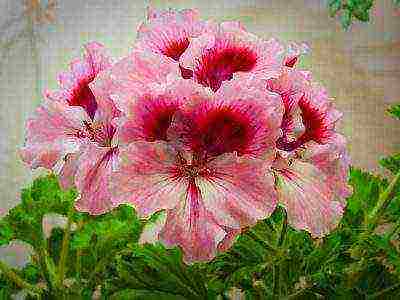Content [show]
About roses with a fashionable name spray became known recently, at the turn of the century, and they gained wide popularity even later - at the beginning of the XXI century. Cultivars with bright buds collected in a brush used to belong to the Floribunda group, but the rapid increase in the number of these beautiful flowers allowed them to be distinguished into a separate group. Spray rose is very decorative and elegant. It is appropriate in any flower arrangement - in a flower bed or in a wedding bouquet. This article offers a description of the most exquisite varieties of roses, as well as recommendations for their cultivation.
Description of the species
What is spray roses and what is their difference - this question may interest not only beginners, but also experienced flower growers. Roses belonging to the spray group have all the characteristics of Floribunda, with the only difference that they are more compact and undersized.
The bushes of this rose are 40-50 cm high, although some varieties can grow up to 80-90 cm. The flowers are small, sometimes even miniature, 3-7 cm in diameter (depending on the variety), arranged in clusters of 10-15 pieces per branch ... The buds can be elegant goblet or densely doubled in different color shades.
One cut off branch may well be considered an independent bouquet, which is why spray roses are often called "bouquet" roses. They are also great as a background for larger flowers, or in mini-bouquets, therefore florists use these flowers most often in wedding bouquets.
Like Floribundas, spray roses bloom very long and profusely. With proper pruning, flowering lasts almost all summer. In addition to being highly decorative, they are very unpretentious to conditions and winter-hardy, which allows them to be grown in the climate of the middle zone and even in cooler regions.
Another nice feature of roses is the small number, and sometimes the complete absence of thorns, which makes them easy to care for and make bouquets. In recent years, spray roses have been increasingly used in landscaping and home gardening. They are equally beautiful both in a flowerbed and in a single planting, and the small size of the plants allows them to be grown in pots and containers.
The best varieties of rose spray
The rapid popularity of flowers contributed to the fact that new varieties of a wide variety of shapes, sizes and color palette began to appear regularly:
- Lovely Lidia (Favorite Lydia) - one of the very first varieties bred in Holland at the end of the twentieth century. The bush is quite sprawling, about 70 cm high. The flowers are small (3-4 cm), pink, lighter on the edge, darker in the middle.
- Mimi Eden (Mimi Eden) is an incredibly beautiful and elegant rose of a white-pink palette. The buds are light apricot, as they bloom, they become pale pink, eventually fade in the sun and become white.
- Tamango (Tamango) is a very compact (about 50 cm high) and decorative rose. The buds are large (6–7 cm in diameter), densely double (about 40 petals), saturated scarlet, 10–12 buds per branch.The high winter hardiness of the variety allows it to be grown in the cold regions of the country.
- Typhoon (Typhoon) - very bright rose with double buds of rich orange color. The edges of the petals are red, towards the middle they smoothly turn into yellow.
- Satin (Satin) - amazing beauty rose with marble two-color buds. The flowers are large (up to 8 cm), bright pink with cream stains.
- Tiramisu (Tiramisu) is another spectacular variety with two-colored buds, bred in Holland. Roses are small, inside the petals are terracotta, outside are creamy, one brush contains 12-15 flowers. The bush is compact (up to 50 cm).
- Rubicon (Rubicon) - a very exquisite rose of dark purple color. The buds are large, goblet, the aroma is light, refined.
- Orange spray (Orange spray) - a new variety of roses with bright orange color of the petals. The buds are small (3-4 cm), resemble a tea rose in shape, and exude a light aroma.
Planting and caring for the bush
Growing roses with spray is a pleasant and fun process. For planting, choose a place protected from the winds, sunny or slightly shaded. Roses of light shades can be planted in the sun, but varieties with dark buds are best placed in light partial shade, since the flowers quickly fade in the sun.
The planting process consists of the following stages:
- digging a planting hole about 45 cm wide and deep;
- laying the drainage layer (sand, small pebbles);
- it is advisable to lay organic fertilizers on top of the drainage (dry leaves, compost, well-rotted manure);
- sprinkle fertilizers with a layer of earth;
- place a bush on the formed mound, spread the roots and carefully cover it with earth.
After planting, the rose should be well watered at the rate of 6-8 liters of water per bush. The water should be settled and not cold, and it should be poured into a small depression made around the seedling.
Caring for roses spray is required uncomplicated. They love regular watering, especially during the flowering period. To prevent moisture from evaporating, the ground can be covered with mulch. In the absence of mulch, the soil must be regularly loosened and cleaned of weeds. In hot weather, burns may appear on the leaves and petals of flowers. To avoid this, periodically the bushes need to be sprinkled.
For a lush and long-lasting flowering, roses need top dressing. In the spring, before flowering, nitrogen-containing fertilizers are applied. Flowering shrubs need more phosphorus, potash fertilizers and trace elements. Despite the high frost resistance, the bushes need to be spud and covered for the winter.
Pruning for roses is of great importance - it stimulates and prolongs flowering, and also promotes the formation of new shoots (rejuvenates the bush). It is necessary to carry out pruning several times during the season: sanitary in spring, forming in autumn. In the summer, it is necessary to regularly remove faded buds, as they not only spoil the appearance of the bush, but also serve as a refuge for pests and microbes.
Video "Rooting a rose from a bouquet"
In this video, you will learn how you can root a rose from a bouquet yourself.
Spray roses are a relatively new group of roses. This group appeared only in the second half of the 20th century and has already managed to fall in love with flower growers from all over the world. They are also called patio roses. What is it about spray roses and patios?
The spray group has separated from the floribunda group of roses. They are represented by low compact bushes. The average height is about 50 cm. Although they can grow up to 90 cm. About 15 buds can open on one branch. The flowers themselves can be either large or small. The diameter of the flowers is from 4 to 7 centimeters. Because of a large number of flowers on one bush spray roses are called pink spray.
These are incredibly exquisite and decorative plants. They are used to decorate personal plots, and are also used to create bouquets, including wedding bouquets. Therefore, these flowers are often called "wedding" flowers.
Spray roses combine the best qualities: long and abundant flowering, unpretentiousness to conditions of detention and endurance... They can be grown in central Russia due to good frost resistance.
There are not so many thorns on the stems, or they may be completely absent. If the flowers are properly cut, then you can get a long and continuous flowering - with the onset of heat and until the first frost.
Culture is actively used in landscape design. They are grown in containers as well as along paths.
The flowers have a light pleasant aroma.
In the title photo, the Evelyn variety.
Varieties
As a result of breeding work, a huge variety of varietal varieties were bred. In this regard, rose spray appeared with flowers of different colors, shapes and sizes. Varietal types of spray roses differ in the size of the bushes, flower colors. There are red, pink, white, yellow, orange colors and their shades.
Pink and cream
Lovely Lidia - This is a spray rose sample. The variety appeared at the end of the 20th century in Holland. The height of the bush does not exceed 70 cm. In width it grows up to 50 cm. The flowers are bright pink in color, shimmering from bright crimson to pale pink. A loose flower can have a dark core. The diameter of the flower is about 4 cm. Love Lydia has a long and continuous flowering. The variety is resistant to frost and disease. Lydia is effective for container plantings, in the foreground in flower beds, as well as for bouquets.
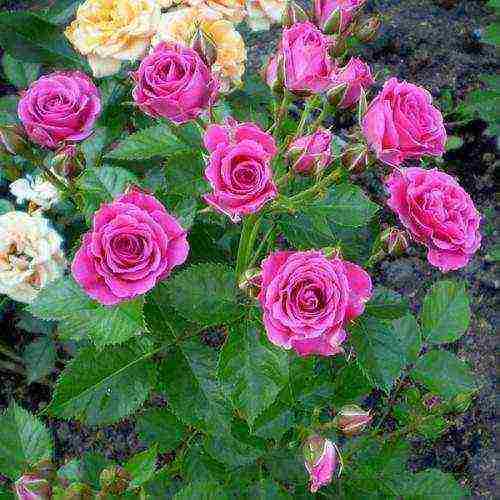
Lovely Lydia
Yana - decorative varietal variety. Bushes are compact. Height - up to 60 cm. Long-lasting and abundant flowering. The diameter of pale cream flowers is up to 6 cm. The aroma is pleasant, barely perceptible. Can be used to decorate curbs and alleys.

Yana
Mimi Eden- incredibly elegant spray rose with double double-colored flowers. Inside, the petals are pale pink in color, and on the outside they are almost snow-white. The flowers are not large, there are about 10 of them on one stem. Blooms from early summer until the first frost. The bush grows up to 85 cm, and grows in width up to 1 meter. Mimi Edem will adorn absolutely any flower garden due to its unique sophistication.
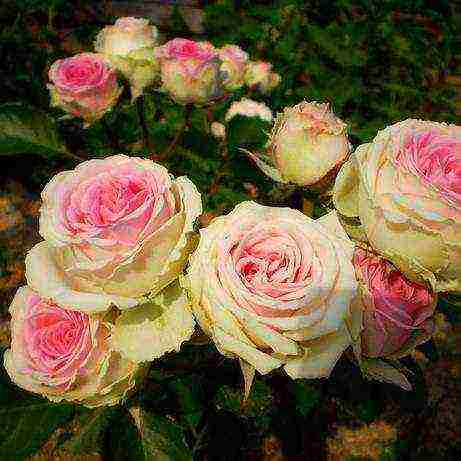
Mini edem is another way to spell the name of the variety.
Barbados - Dutch spray rose with pink flowers of fairly large sizes. The bush grows up to 70 cm. The aroma is not pronounced. Barbados is frost-resistant. It can be used to decorate borders, as well as create a unique accent in landscape compositions.

Barbados
Deep water - an original, profusely flowering bush with double flowers of medium and fairly large sizes. Inside, the petals are pale pink in color, while the outer petals are lilac with hints of red. Deep water is used to decorate gardens, as well as to create bouquets.

Deep water
Hiho spray - a rose with deep pink double flowers. Their size is average. Up to 20 flowers are collected from the inflorescence. Flowering is profuse and long lasting. The aroma is almost invisible. The bush can reach heights of up to 1 meter. Due to its bright color, this varietal variety will be an excellent decoration for a flower garden.

Hiho
Evelyn - a low (about 60 cm) plant with pale pink dense double flowers. You saw her in the title photo. When dissolved, the flowers are apricot in color, and as they unfold, they acquire pink hues. In hot weather, the color becomes more saturated, but in the sun the petals can fade to white. The flowering is profuse and long lasting.

Evelyn
Grace - another spectacular spray rose, blooming with pink medium-sized flowers. The bush can grow up to 80 cm. There is a pleasant, light aroma. The variety is often used for making bouquets. Plants stand for a long time in cut.

Grace
Lancome- spray rose with thick double hot pink flowers. Bushes grow up to 60 cm.The variety is distinguished by long and abundant flowering, frost and pest resistance.

Lankom
Bonica- a romantic varietal variety up to 100 cm in height. The color of double flowers is pale pink. Diameter 6 cm. The clusters can hold up to 15 buds. The scent is barely noticeable. The culture blooms profusely and before frost. The variety is frost-resistant.

Bonika
Satin - amazingly beautiful plant with two-color flowers (diameter up to 8 cm). The color is bright pink with cream spots. The growth of the bush is no more than 70 cm. The aroma is pleasant, barely perceptible. The variety is resistant to frost and rain. It rarely gets sick.

Satin
Lidelaike - a spectacular bush no more than 60 cm high. Terry flowers are bright pink, almost white closer to the center, look very beautiful against the background of dark green foliage.
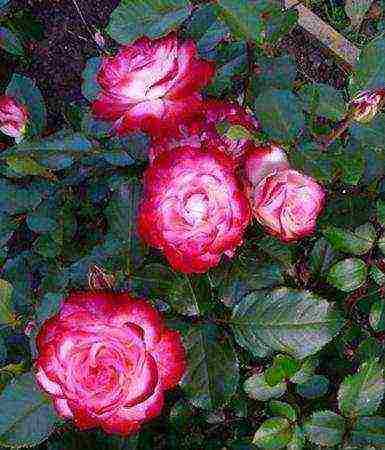
Lidelaike
Pink Intuition - another original plant. The flowers are marbled with bright pink strokes on the petals. The flowering is profuse and long lasting. The smell is fruity, weak.

Pink Intuition
Jessika Is an elegant, profusely flowering variety. The flowers are light pink in color, the edges of the petals have a brighter pink tint. Often used to create bouquets.

Jessica
Victoria (Viktoria)- decorative variety with double pink salmon flowers. The bush grows up to 60 cm in width and height. Victoria is suitable for creating bouquets, for growing in the foregrounds in flower beds.
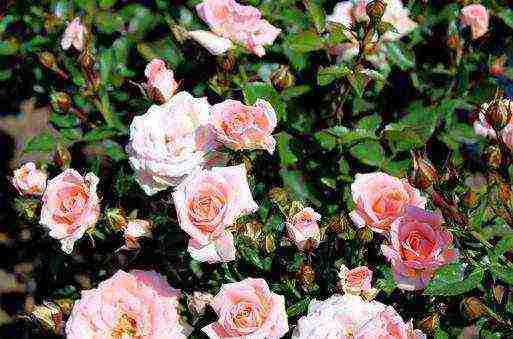
Victoria
Glorius- an ornamental bush with double, bright crimson flowers, the diameter of which does not exceed 5 cm. Abundant and long-lasting flowering. The aroma is pleasant, weak. Glorius was bred in Holland.

Glorius
Little Dream - a profusely flowering variety. The bush grows up to 60 cm. It blooms with creamy flowers with a pink tint. Little Dream is resistant to frost and disease. Differs in decorativeness and elegance.
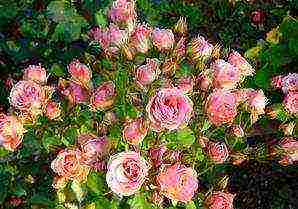
Little Dream
Yellow and orange
Mandarin Is another popular variety. The bush has a height of up to 60 cm. About 5 medium-sized (about 4 cm in diameter) flowers open on one stem. They are tangerine or orange in color. Closer to the center, the shades are lighter, and the edges of the petals are distinguished by a rich orange color. The varietal variety is very effective, therefore it is actively used to decorate gardens.
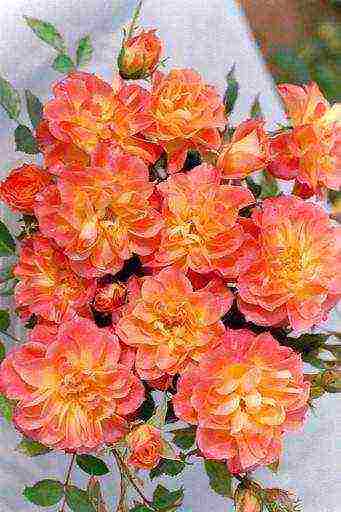
Mandarin
Sphinx - spray rose about 60 cm high. Flowers are large enough and rich yellow color. They have a pleasant, weak aroma. Long-lasting flowering. The variety is resistant to frost and disease.

Sphinx
Fire Flash Is another spectacular varietal variety. It is called a flash of flame due to its bright and abundant flowering. The height of the bush is no more than 60 cm. The flower is bright yellow with orange strokes on the petals. Diameter - no more than 4 cm. This is a very elegant variety that will decorate any flower garden or bouquet arrangement.

Fire flash
Kelly - incredibly beautiful spray rose. On stems about 70 cm high, there are about 10 buds. The flower is orange with a salmon tint. The diameter can be up to 7 cm. The variety is best grown in partial shade, as the color fades in the sun. Kelly is resistant to frost, can rarely be affected by pests. The effectiveness of the variety allows you to grow it in containers, flower beds, along the paths.
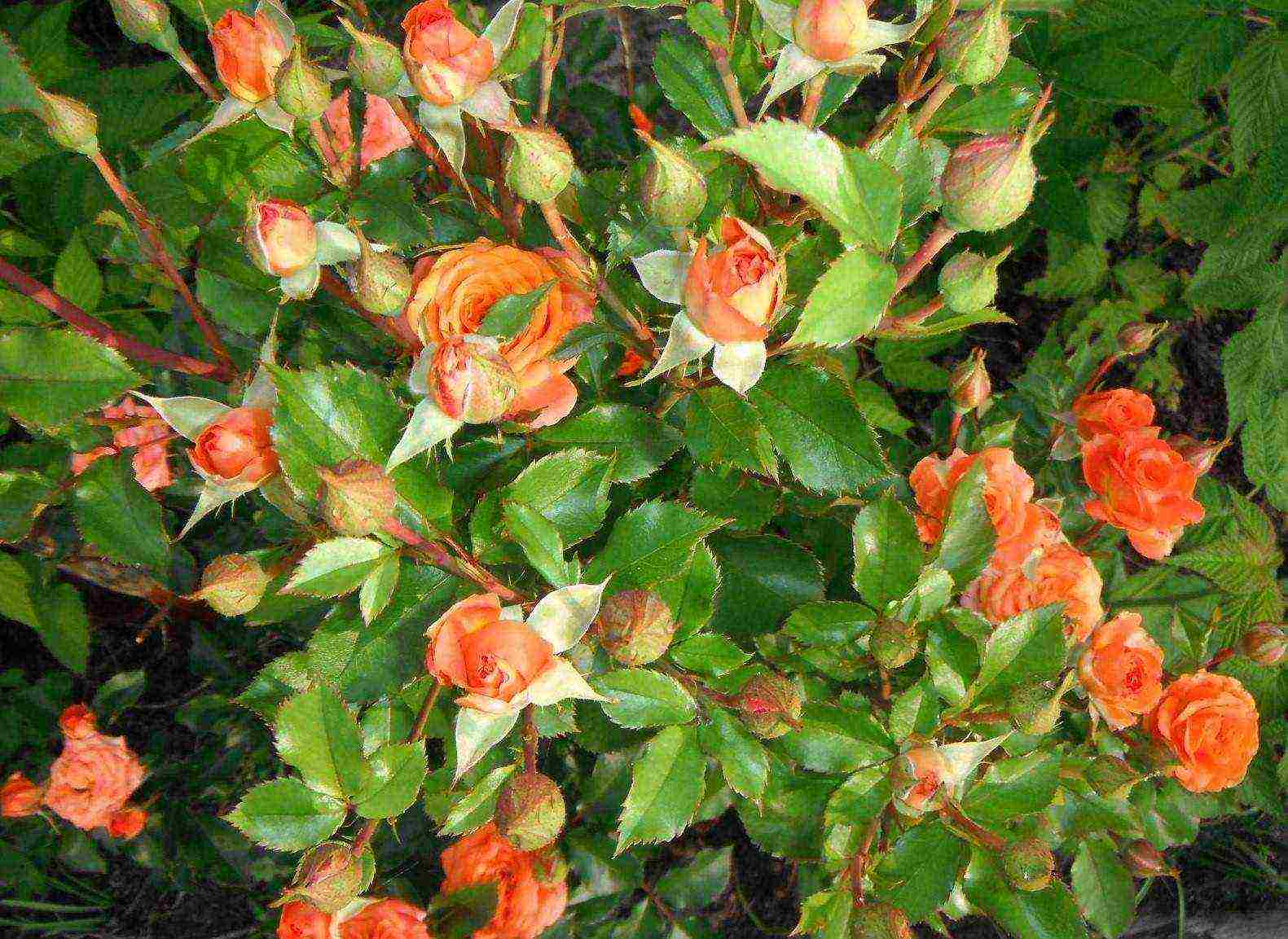
Kelly
Summer - a variety with lemon flowers up to 8 cm in diameter. One stem can have up to 5 buds. Long-lasting flowering. Summer is frost and disease resistant.
Samba - spectacular spray rose no more than 60 cm high. Flowers are medium-sized, double. The color is yellow, there is a wide red border on the petals. The variety is frost-resistant and resistant to pests and diseases. Flowering lasts throughout the season.
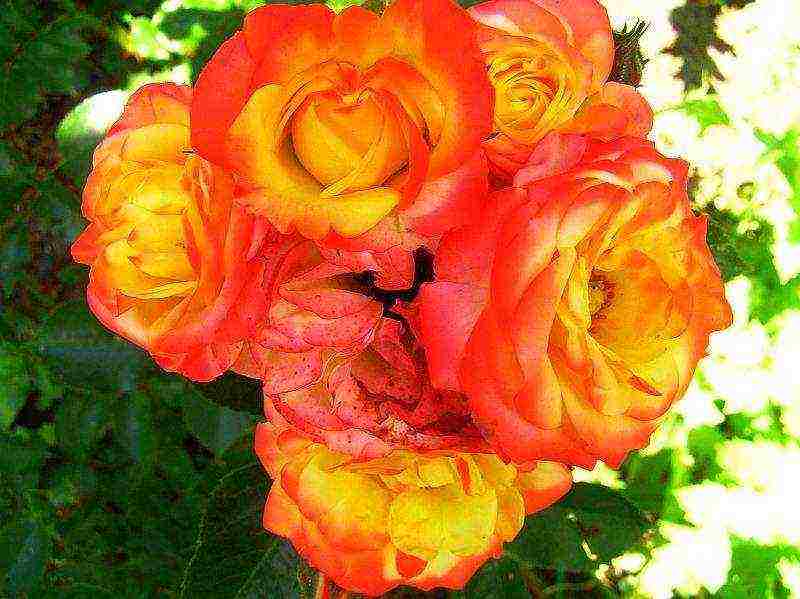
Samba
Hit - spray rose with dense double flowers. The inner petals are yellow and the outer petals are pinkish. The bush itself is undersized, no more than 40 cm.
Clementine - one of the most popular varieties. Flowers, when dissolved, have a pinkish tint, then take on a peach or tangerine color. In addition, citrus notes can be caught in the aroma. The diameter of the flowers is about 5 cm. On one stem, they can be counted about 5 pieces. The height of the bush is up to 60 cm. The variety is resistant to frost and diseases.
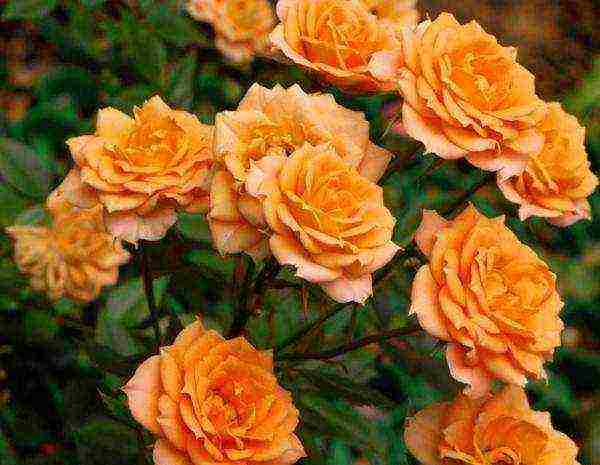
Clementine
Macarena Is a popular varietal variety bred in Holland. When opened, flowers, the diameter of which does not exceed 5 cm, differ in a pale yellow tint, and then acquire a juicy pink color. There are up to 10 flowers on the stem with a delicate light aroma. The bushes are compact and flowering for a long time. Macarena is resistant to frost and disease.
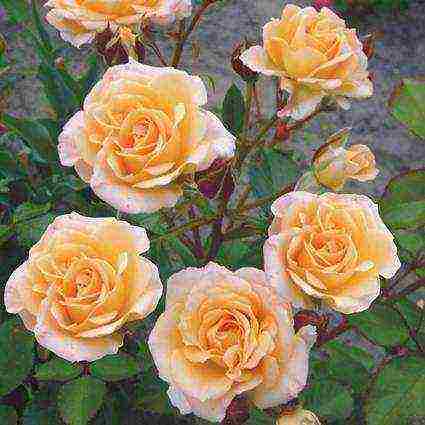
Macarena
Sun city - bright yellow spray rose. Dense double flowers, size - 8 cm, lemon color. The shrub grows up to 60 cm. It is used for growing outdoors and in containers. The variety is frost resistant. Long-lasting and abundant flowering.
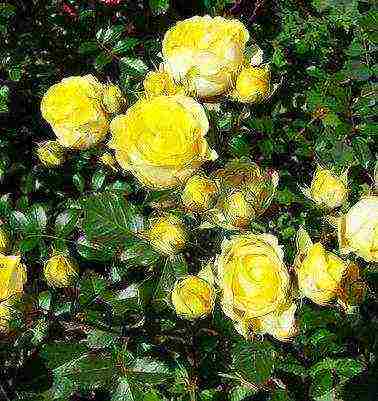
Sun city
Orange spray- a rose of bright orange color. The variety was recently bred. Bushes are dense and compact. The height is up to 60 cm, the diameter of the bush is about 40. The flowers are shaped like a hybrid tea rose. Their diameter is about 4 cm. They are distinguished by a light aroma. Orange spray is resistant to frost, pests, and is not afraid of rains. The flowering is profuse and long lasting.

Orange spray
Alegria - a very delicate varietal variety with double orange flowers with a pink tinge, the diameter of which does not exceed 5 cm. Alegria is resistant to frost and diseases. Grown for decoration of gardens, as well as for creating bouquets.

Alegria photo
Orange Baby- a bright varietal variety. Blooms profusely and for a long time with orange flowers with a red tint. It is used for decorating borders, as well as for growing in containers.
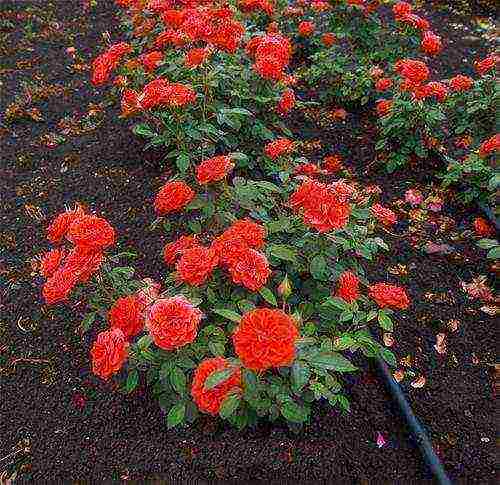
Orange baby
Jazzabel (Jezzebell) - bright spray rose with orange inflorescences. Diameter - about 4 cm. One stem can have up to 10 buds. Blooms from June until frost. The bush grows up to 1 meter.
Risen Shine- a popular pale yellow variety of spray roses. Often used as curbs, since the bush grows no higher than 50 cm. Flowering is abundant and long.
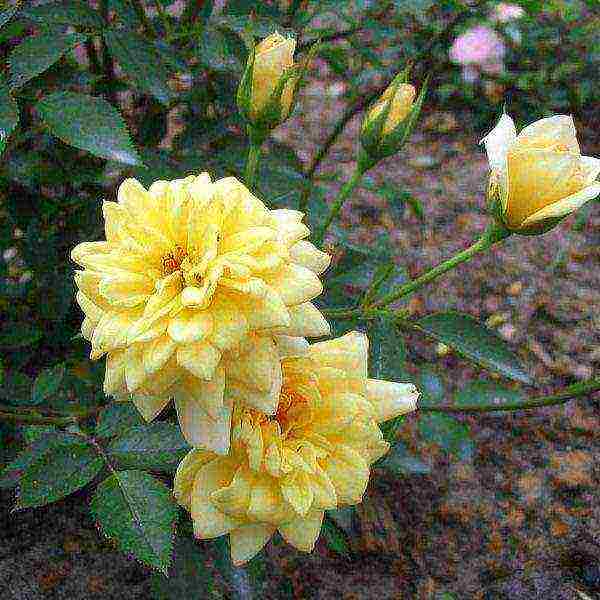
Ryzn Schein
Rumba - another bright spectacular varietal variety. The flowers, when opened, have a deep yellow color, gradually taking on pink and crimson hues. Up to 15 of them can grow on one stem. All of them are not similar in color to each other, which makes the bush unique and very decorative. The growth of the bush does not exceed 70 cm. Flowering is long and abundant. The variety can bloom again.

Rumba
Typhoon differs in long and abundant flowering until the onset of frost. It blooms with double bright orange flowers. Their diameter can reach 5 cm. The growth of a bush rarely exceeds 70 cm. On one stem, they can grow up to 10 pieces. Rumba is frost and disease resistant.

Typhoon photo
Zorenka - brightly blooming, showy variety. Densely double flowers are yellow in color, there is a scarlet border along the edges of the petals. The height of the bush is no more than 70 cm. The flowering is abundant and long lasting until frost.

Zorenka
Pareo - varietal variety with reddish orange flowers. Closer to the edges, the petals become brighter. Height - no more than 60 cm. Used to create bouquets and to decorate gardens.
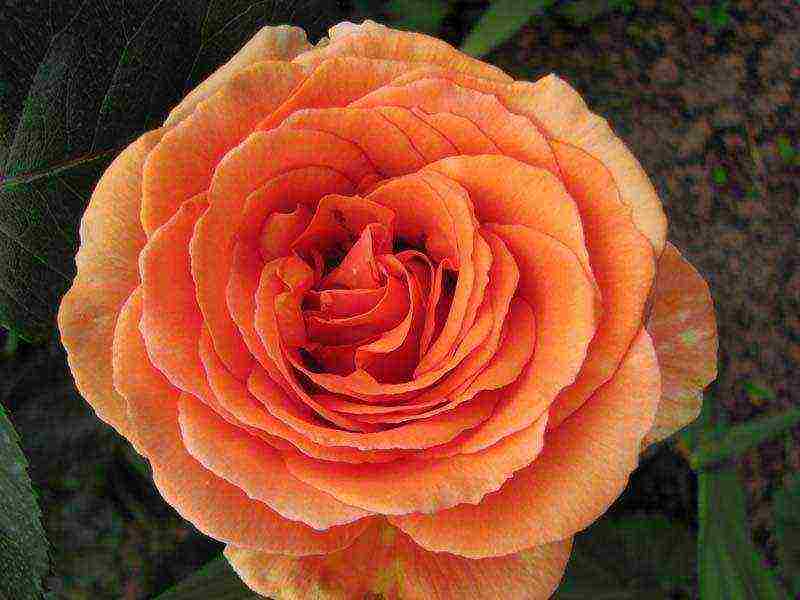
Pareo
Tibet - orange-red rose spray. The plant can grow up to 90 cm. The flowers have a goblet shape, visually resemble the flowers of a hybrid tea rose.

Tibet
Red
Tamango- it is a bush up to 60 cm high and about 50 cm in diameter. It is distinguished by the compactness of the bush and abundant and long flowering. Velvet flowers are quite large (about 7 cm in diameter) and consist of a large number of petals. On one branch there are up to 10 red flowers with a raspberry shade. The variety is resistant to frost and disease.The plant can grow both in the sun and in the shade. Tamango is successfully used for garden decoration.

Tamango
Natalie - ornamental variety, height no more than 70 cm. It is a compact and abundantly flowering plant. The flowers are medium-sized - their diameter is about 5 cm. They are distinguished by a subtle aroma. The color is red. The plant is frost-resistant and is effectively used in landscape design for landscaping gardens and for creating bouquet arrangements.
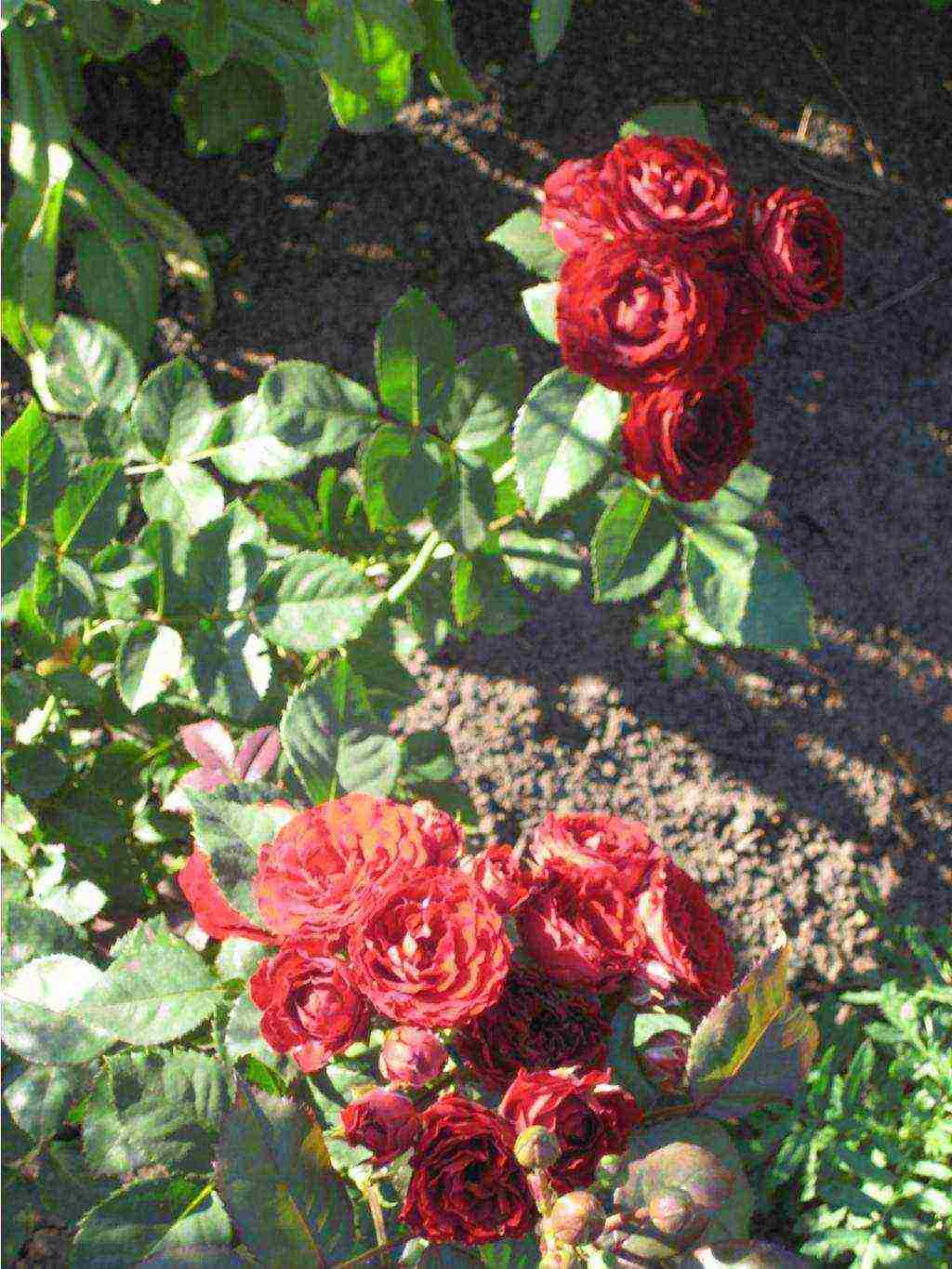
Natalie
Midget - spectacular red spray rose. The height of the bush is only 25 cm. Therefore, the variety is often used for decorating borders and for planting along alleys. The flowers are small in size - their diameter does not exceed 3 cm. There is practically no aroma. Bushes are compact with abundant flowering. The midget is resistant to frost and pests.

Midget
Leili flirting - elegant varietal variety. Terry flowers are bright red with a yellowish center. The edges of the petals are burgundy. The bush is undersized (no more than 40 cm).
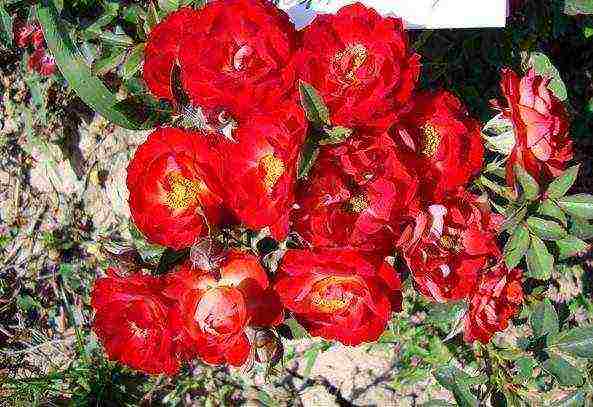
Leili Flirt
Mikado - dark red rose with goblet-shaped double flowers. A compact shrub with a height of about 70 cm is distinguished by spreading shoots and abundant flowering. One brush can have up to 6 buds. The variety is unpretentious, resistant to frost and pests. Looks spectacular in the foreground in flower beds, and is also used to decorate paths and borders.

Mikado.
Baby Baccara - a very showy plant with abundant flowering. The color of the double flowers is deep red. Diameter no more than 6 cm. The aroma is pleasant and light. This varietal variety is often used for growing in containers, flower beds and for lining alleys.

Baby baccarat
Mirabel - bright, low (up to 50 cm) compact bush with abundant and long flowering. The medium-sized flowers have a rich scarlet color, which are luxurious against the backdrop of glossy green foliage. Mirabelle has a light, pleasant aroma with fruity notes. The variety is resistant to frost and pests.

Mirabel
Sveta - spray rose, characterized by unique decorative properties due to lush red flowers with yellow strokes. The bush grows up to 70 cm in height and grows by the same amount in width. The bush is distinguished by abundant and long flowering up to frost.
Arrow Follies- an original decorative culture with a bright and abundant flowering. Bushes no more than 70 cm high are completely covered with elegant double flowers. Coloring - red with a purple tint. The petals have white and cream strokes. Errow Folis is used for single and group plantings and is often grown in containers.
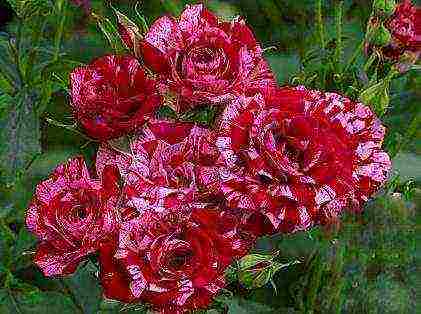
Rose spray ario foles
Fire King Flash - profusely flowering bush up to 85 cm high. Flowers are double, bright red. One brush can have up to 15 buds. The variety is resistant to frost and disease.

Fire king
Black Jack - spray rose, has spectacular decorative properties due to rich red, abundant flowering. The variety was bred in the United States at the end of the 20th century. One bush, which grows up to 60 cm, can have up to 30 buds. Roses are of medium size (no more than 5 cm).
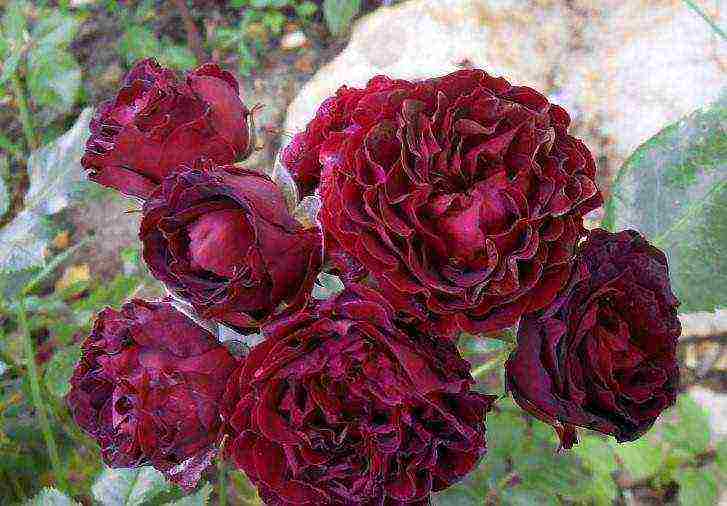
Black Jack
Cherry Folies - a beautiful compact bush with deep red goblet flowers with an almost white base. The aroma is pleasant, weak. The varietal variety is frost-resistant.

Cherry folies
Rubicon - an exquisite varietal variety. Sufficiently large flowers have a dark red color. The variety is grown outdoors, but is more often used for cutting to create bouquets.

Rubicon
Ruby Star - two-tone spray roses with bright red flowers, the outside of the petals have an almost white tint. The variety is unpretentious, blooms throughout the season. Suitable for growing in containers and for framing borders.

Ruby Star
Sasha - red rose spray.The petals have orange streaks. The roses are about 6 cm in size.The height of the bush is up to 60 cm.

Sasha
Terracotta - a compact bush no higher than 70 cm. Flowers are densely doubled, have a deep red color with an orange tint.
Sangrita - bright red, miniature spray rose with small double cupped roses. It blooms for a long time and abundantly. Used for bordering, also grown in containers.
Red Sensation Is an American varietal variety of incredible beauty. Medium-sized flowers have a deep burgundy color. The bush itself is not higher than 70 cm, it can grow up to 1 meter wide. The variety is unpretentious, winter-hardy.

Red Sense
Other
Paple Tiger (Purple Tiger)- one of the most spectacular rose spray. Dense double flowers have a unique color - purple-lilac with white strokes and spots. In this case, lilac and pink shades can also be added. One brush can contain up to 5 colors. Diameter - about 6 cm. Flowering is long, often blooms again. The bush grows up to 70 cm. The light aroma contains notes of musk. The variety is used to decorate borders, and will also become a unique decoration for flower beds and recreation areas.
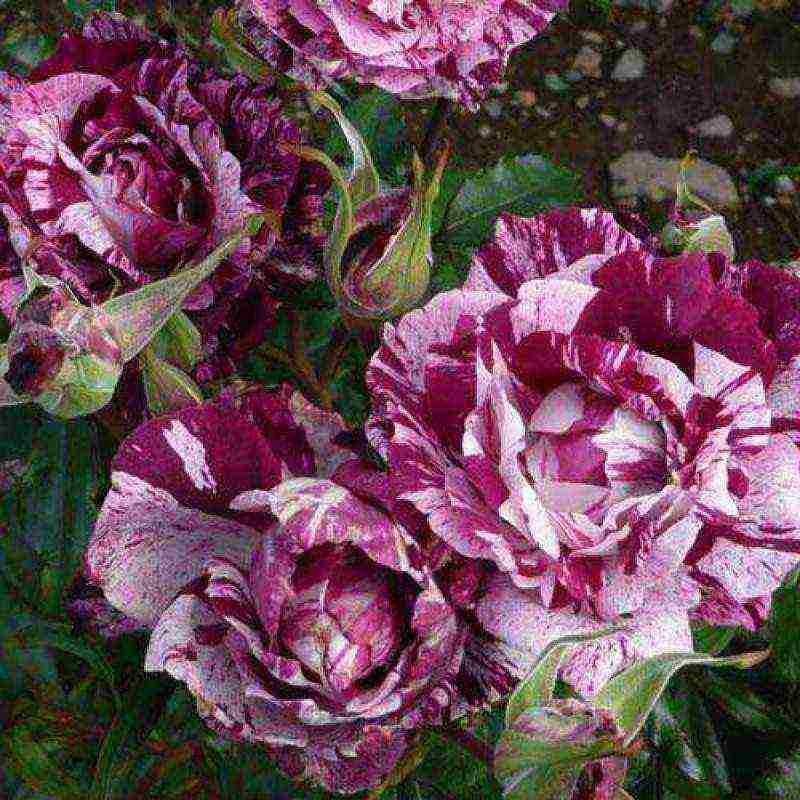
Paple Tiger
Princess (Pricess) - an elegant plant with densely doubled snow-white flowers that bloom throughout the season until frost.
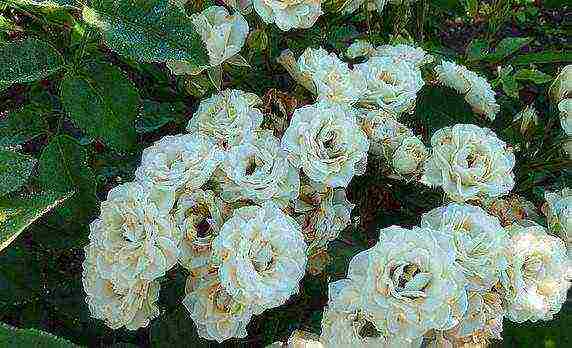
A princess
Kent - a compact bush covered with numerous small snow-white flowers. The bush grows up to 60 cm in height and width. Long bloom until frost.
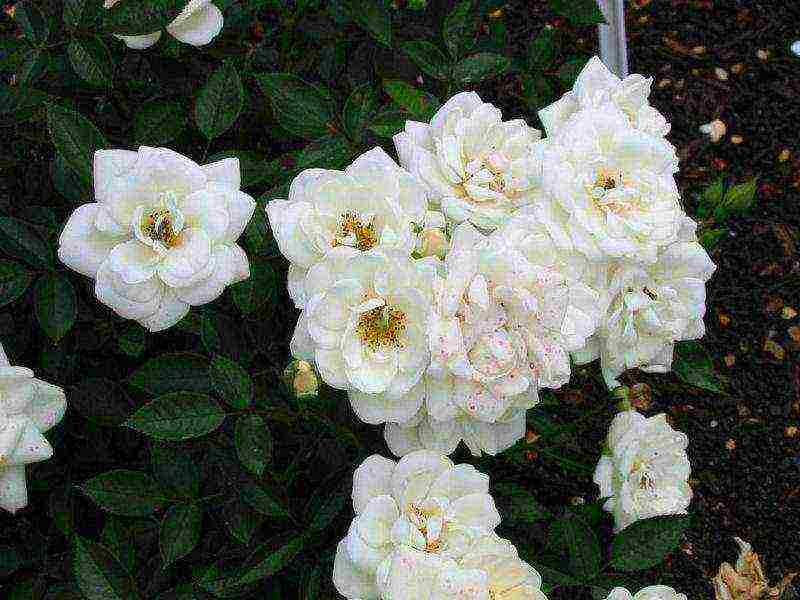
Kent
Droplet - spray rose no more than 40 cm in height. This crop is suitable for growing in garden plots, for edging paths, as well as for growing in containers, including on balconies. colors are varied: red, pink, purple.
Abracadabra - unusual rose spray. Small flowers have an almost burgundy color with yellow strokes. The height of the bush is about 60 cm. Abracadabra is used for growing outdoors, in containers, and is also suitable for creating bouquet arrangements.
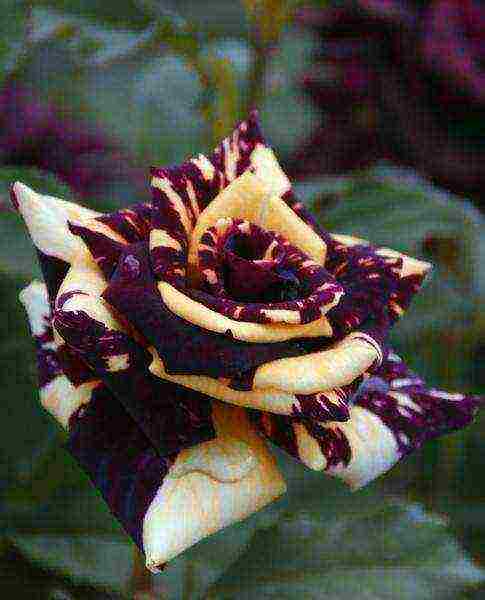
Abracadabra
Orion - a very delicate spray rose with large flowers that have a lilac hue. Blooms profusely and for a long time. Resistant to frost.
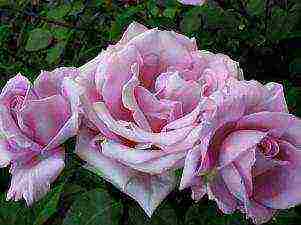
Orion
Bordeaux Is a very elegant variety with medium-sized maroon flowers. The bush is compact, has a height of no more than 60 cm. One cluster can contain up to 12 buds. Used for cutting, for growing in containers and outdoors.
Tiramisu- a spectacular varietal variety. Small roses have an unusual color. On the inside, it is terracotta, and on the outside it is cream. Height - no more than 50 cm. The variety comes from Holland.

Tiramisu
Where can I buy?
You can buy seedlings of these amazing crops in nurseries, gardening stores, buy seedlings of spray roses by mail or through the online store.
| Variety | Where can I buy | Price |
| Lovely Lydia | Roses of vyatka (nursery, online store) | 320 rubles |
| Pink flush | Rose garden "Kuban rose" | 200 rubles |
| Sasha | LLC "Wonderful Garden" | 350 rubles |
| Midget | Online store "Samara seeds" | 250 rubles |
| Rumba | Roses of vyatka (nursery, online store) | 320 rubles |
Good catalogs of plants can be viewed on the site of the Omsk nursery "Divny Garden", on the site "Bushes of Roses" in the Krasnodar Territory, and in the catalogs of Altai selection there are spray roses of various colors (pink, red, yellow, white and others).
Planting and leaving
Planting spray roses is not a difficult process at all. It is recommended to choose a sunny place for planting. However, some varieties fade in the sun, so a small partial shade is fine.
In order to plant a plant, you will need:
- Dig a hole measuring 45 * 45;
- Put drainage (pebbles, sand) on the base of the fossa;
- Put organic fertilizers over the drainage (dry leaves, rot, humus, manure);
- Plant the plant in a planting hole, cover with soil and compact around the stems;
- Pour with settled and warm water (8 liters of water per bush).
These cultures are unpretentious. From spring to July, fertilizing with a high nitrogen content is required. And in the summer and until autumn, the plant needs trace elements such as potassium and phosphorus. It is very important to apply fertilizers during the budding period and at the end of flowering.
The soil around the stem must be loosened regularly. Watering should be moderate.
Roses need shelter for the winter.
Pruning
Pruning is very important for spray roses. It stimulates the formation of young branches and ensures more abundant and long-lasting flowering. Pruning is recommended several times throughout the season. At the same time, dry and damaged branches are removed. Also, at the end of flowering, it is necessary to cut off the wilted flowers.
It is especially important to prune the bush in the summer so that the plant does not waste energy on the formation of fruits, but blooms more intensely and more abundantly. In addition, pruning is the prevention of fungus.
Reviews and opinions of gardeners
In Russia, the most popular varieties are called Lydia, Ruby Star, Mimi Eden, Fire Flush... Reviews about them are left on the forums more actively than about others. Moreover, these opinions are mostly positive - these varieties deserve them.
Most often, the issue of wintering is discussed. In central Russia, it is advisable to cover the culture for the winter, despite the rather high winter hardiness of all varietal species. It is recommended to cover with spruce branches or needles.
In general, no additional plant care measures are required. The exception is cropping. It stimulates flowering that lasts throughout the season. When pruning at the end of flowering, leave about 15 cm from the soil surface.
It is advisable to purchase grafted bushes in proven stores and nurseries, and plant in the fall, around mid-September.
Application in landscape design
Spray roses are actively used in floriculture and landscape design. They look great in the foreground in flower beds and flower beds. Also suitable for container growing. They can become a decoration of rest corners, verandas, adjoining territories.
Due to their short stature, they are used for framing paths and borders.

Manufacturer's perspective
Greenhouse breeders - how much area should be allocated for spray roses? The eyes of professionals who grow roses on an industrial scale and therefore have the opportunity to compare a really wide range of varieties are always interesting.

This rose was bred in 2001 in France (Meiland). Bushes varieties Mimi Eden from 0.55 to 0.85 meters in height, they can reach 0.9-1.1 m in width. They consist of numerous straight, highly branched branches almost without thorns, covered with dark green leaves of medium size with a slight sheen.
Spherical terry roses with a diameter of 3 to 4 cm are located on peduncles in 5-10 pieces. Each flower can have from 27 to 40 petals. The two-tone color is especially attractive. The inside is painted in a rather rich pink color, while the outside is white with a slight green tint. Powerful flowering of Mimi Eden continues throughout the season (from June to the first frost) 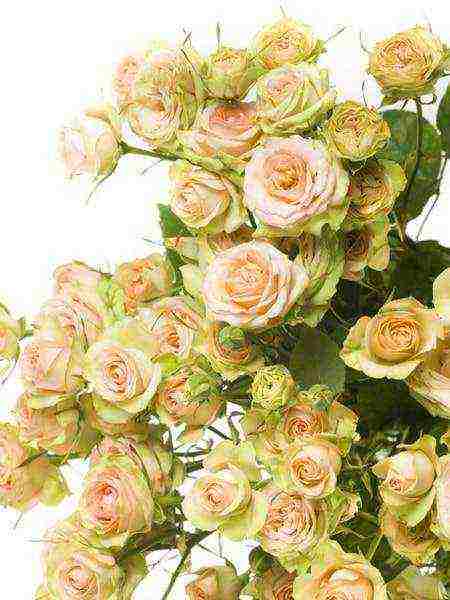
Variety Romantic Pepita created in 2013 in Germany. Narrow and compact bushes (length and width are 0.5-0.6 meters) consist of branched branches looking up, covered with dark green leaves. Quite large cupped roses (5 to 7 cm wide) have many petals (about 45 pieces). They are formed in inflorescences of 5-10 pieces.
I especially like the most delicate combination of watercolor shades of pink and green. The inside of the rose is pink, while the outer petals are light green. I like the Romance Pepita variety for its good frost resistance and tolerance of long rains. 
This rose was bred in 1990 in Holland and was intended for cutting, but later it was planted for landscaping garden and summer cottages. Neat bushes varieties Lydia they reach a height of 0.5 to 0.6 meters, and a width of 0.3 to 0.5 m. They look best in groups of several bushes. Quite large flowers with a diameter of 3 to 6 cm open in small inflorescences, which usually consist of 5-10 pieces.
The color of the buds is bright pink, but as it blooms, it turns into pastel pink. Shows the middle. The Lydia variety is practically not sick with powdery mildew. Flowering repeats several times during all summer months. 
Variety Lovely Lydia, created in the Netherlands in 1995, is considered one of the best rose spray. It is considered a sport of the Lydia variety. Quite compact bushes grow in height from 0.6 to 0.7 meters, and their width can vary from 0.5 to 0.6 m. Small flowers from 30 to 40 millimeters wide bloom in inflorescences of 5-10 pieces. The color of the flowers is striking, which varies from creamy pink to the most delicate crimson. When the flowers are fully open, they show the middle of a dark shade. Flowering, which lasts almost the entire season, is practically uninterrupted.
Love Lydia is perfect for foreground flower arrangements, as well as for cutting in greenhouses. This rose tolerates cold quite well, but has little resistance to powdery rose and black spot. 
Variety Tamango created in 1965 at the Meiland company (France). Small neat bushes (width and height about 0.5 meters) are formed by gently curved and branched branches, which are covered with green-gray foliage with a slight gloss.
Red-crimson flowers with a velvety tint, 30 to 50 millimeters wide, bloom on the bushes in attractive inflorescences from 5 to 8-10 pieces. Each flower has approximately 35 petals. Abundant flowering continues throughout the warm season. The variety is resistant to long-term precipitation 
the Rose Arrow Folies brought out in 2002 in the USA. The bushes of this variety are formed by harsh straight branched shoots with large thorns and are about 0.7 meters high. On the bushes there are large leaves with a slight gloss, which are painted in a dark green color. The size of the bush is only 0.5 meters wide.
Flowers ranging in size from 4 to 6 cm open in inflorescences, which can contain from 5 to 10 pieces. Their color is especially attractive. On the petals of purple-red, transverse stripes of pastel pink and almost white shades are scattered.
Arrow Folis is liked for its luxurious and continuous flowering, as well as for its excellent resistance to rainfall. It is used for planting in portable containers and in groups.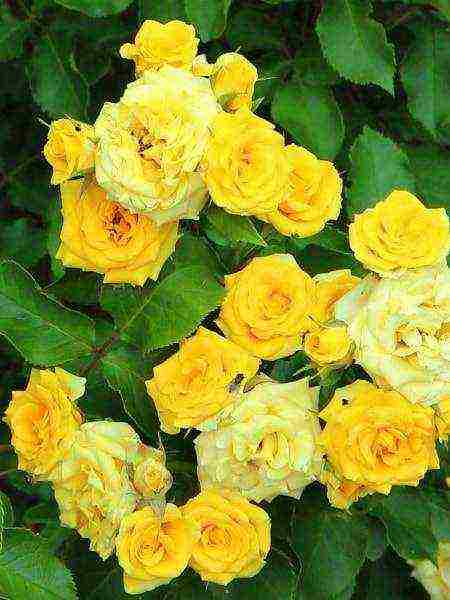
Small but dense bushes of the variety Yellow Evelyn, reaching a height of 0.4-0.6 meters, consist of many branches with leaves painted in a very dark green tint. Attractive double yellow-lemon flowers (45-50 pieces) are collected in inflorescences, which number from 8 to 15 pieces. Moreover, when the roses are just opening, the color is bright lemon, and by the end - pale yellow, almost white.
Multiple flowering lasts almost all warm seasons 
Variety Macarena was bred in the Netherlands. Small and rather dense bushes are from 0.4 to 0.6 meters in height. And their width is only about 40 cm. They are formed by straight, highly branched branches with shiny leaves of a dark green hue.
Yellowish and pastel pink flowers about 4 cm in size bloom from spectacular yellow buds, which are collected in large inflorescences, consisting of 9-12 pieces. During flowering, the color of the roses becomes paler. Macarena stands out among other varieties for its resistance to high temperatures 
Variety Alegria created in 2007 in the Netherlands.Quite narrow bushes with a height of 0.6 to 0.7 meters consist of rigid, straight branches. Orange-pink flowers, resembling a neat glass in shape, are collected in 25-30 pieces in bouquet inflorescences. The flower is about 50 millimeters wide.
Almost continuous flowering lasts until frost. In years with a lot of rainfall, black spot may appear on plants. 
Variety Hot Rococo very young variety. It was received only in 2013 in Germany (Tantau). Bushes of a compact form, 0.6 meters high and 0.4 meters wide, consist of numerous strong and branched branches, which are covered with leaves of a dark, dense green shade with shine. Quite large flowers of bright dark red color with many petals are formed on peduncles in an amount of 1 to 3 pieces.
The Hot Rococo cultivar attracts attention with its good disease resistance. It is suitable for foreground landscape compositions, as well as for cutting 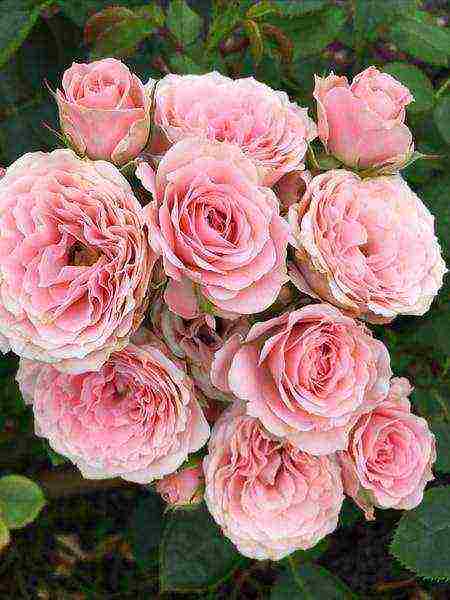
Variety Sisi Mikado also brought out by the well-known German company Tantau in 2012. Quite dense bushes, reaching a height of 50 to 70 cm, are formed by straight branches with a large number of branches.
Round pink buds with a pointed end appear in bouquet inflorescences of 5-10 pieces. When blooming, they turn into cupped roses of a very delicate pink shade with a dark center. Sissi Mikado looks great in portable containers and in groups 
Variety Ruby Star was obtained from the Dutch firm Interplant. Quite dense bushes, reaching a height of 0.6 to 0.7 meters, are formed by branched branches with leaves of a dark greenish-gray color.
Spectacular two-colored roses with a slight aroma ranging in size from 4 to 5 cm on the bushes appear in inflorescences of 6-11 pieces. The inside of the petals has a deep red tint, while the outside is almost white. The elongated shape of the bud, reminiscent of a glass, attracts attention. Quite disease resistant 
Variety Tiramisu also created in the Netherlands (Interplant). Straight bushes, reaching a height of 0.7 meters, are covered with small leaves that have a bright green tint. The size of the bush in width usually varies from 40 to 50 cm. Terry flowers (from 25 to 35 petals) with a slight aroma with a diameter of 2 to 3 cm open in inflorescences - bouquets of 5-10 pieces.
The inner surface of the petals has a red-terracotta hue, and the outer surface is creamy-whitish. There are 2 to 3 flowering waves per season. 
Variety White Mikado attracts attention with rather large snow-white flowers 6-7 cm wide. Not very wide bushes, 60 to 70 cm high and half a meter wide, consist of erect branched branches. Flowers, consisting of 20 petals, are located on the peduncles of 3-5 pieces. Flowering is repeated 2-3 times during the growing season.
White Mikado is poorly resistant to disease 
Variety Barbados was obtained from the well-known firm Interplant (Netherlands). Quite neat bushes (height from 0.6 to 0.7 m, width - 0.6 m) consist of branched branches with shiny leaves of a dark, dense green hue. Large roses (diameter from 6 to 7 cm) of an attractive bright pinkish-coral shade are located in inflorescences of 3,4,5 pieces. Flowering can be repeated 2 to 3 times.
This variety is best used to create group plantings and curbs. 
Rose bushes varieties Cherry Fallis, reaching a height of 50 to 60 cm, they have a rather compact shape. Straight, slightly branched shoots are covered with small leaves with pointed tips. Spectacular roses ranging from 30 to 50 millimeters wide have about 40 petals.
They open in 8-10 inflorescences. The dark red color with a deep cherry tint is especially attractive. The middle of the rose and the outside of the Cherry Folies petals have a light creamy shade.Long bloom repeats throughout the season. Good resistance to various diseases attracts attention 
Variety Orange Beyb I like it for the juicy bright orange color of the flower. The bushes, the length and width of which are from 0.5 to 0.6 m, are covered with medium-sized leaves of a bright green hue with a shiny surface. The diameter of roses, consisting of 35-40 petals, can vary from 40 to 50 millimeters. Flowers appear on powerful peduncles in inflorescences of 6-10 roses. Abundant flowering (multiple) begins in June and ends in October.
The Orange Baby variety attracts attention with its good rainfall tolerance. Has an average resistance to disease. 
Variety Mirabel was obtained in the Netherlands (Interplant). Bushes 60 to 90 cm high consist of upward-looking shoots covered with medium-sized, dark green shiny leaves. Reddish-scarlet roses with a slight aroma bloom on branched peduncles (from 4 to 6 pieces).
May fade slightly in the sun. Flowering can be repeated several times per season (2-3). This variety is quite resistant to rain and disease. 
Variety Fire Flash brought out by the firm Interplant (Netherlands). Quite narrow bushes, reaching a height of 0.6 to 0.7 meters, are covered with a mass of leaves painted in a bright green hue. Large flowers with a width of 50 to 60 millimeters are liked for their striped two-tone yellow-red color, which can fade in the sun.
Flowering is repeated up to three times per season. A bouquet peduncle can consist of 5-10 roses. The Fire Flush variety withstands precipitation well and is quite resistant to diseases 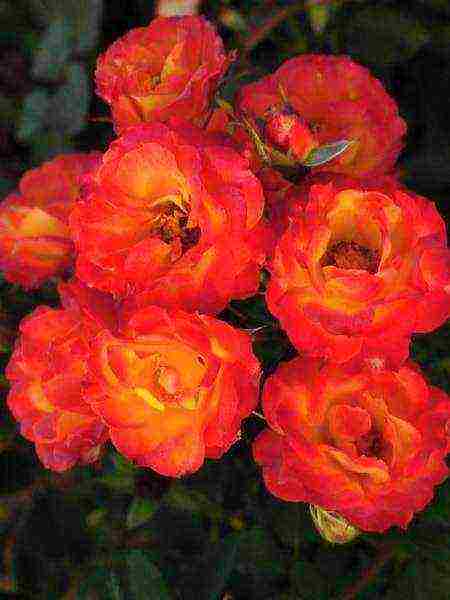
Variety Typhoon It stands out with bright yellow-orange flowers of a beautiful modern shape, which have many petals. Their diameter can vary from 4 to 5 cm. The flowers have a slight aroma. The height of the bush can vary from 60 to 70 centimeters.
Spray rose variety Typhoon perfectly withstands high rainfall and disease resistance 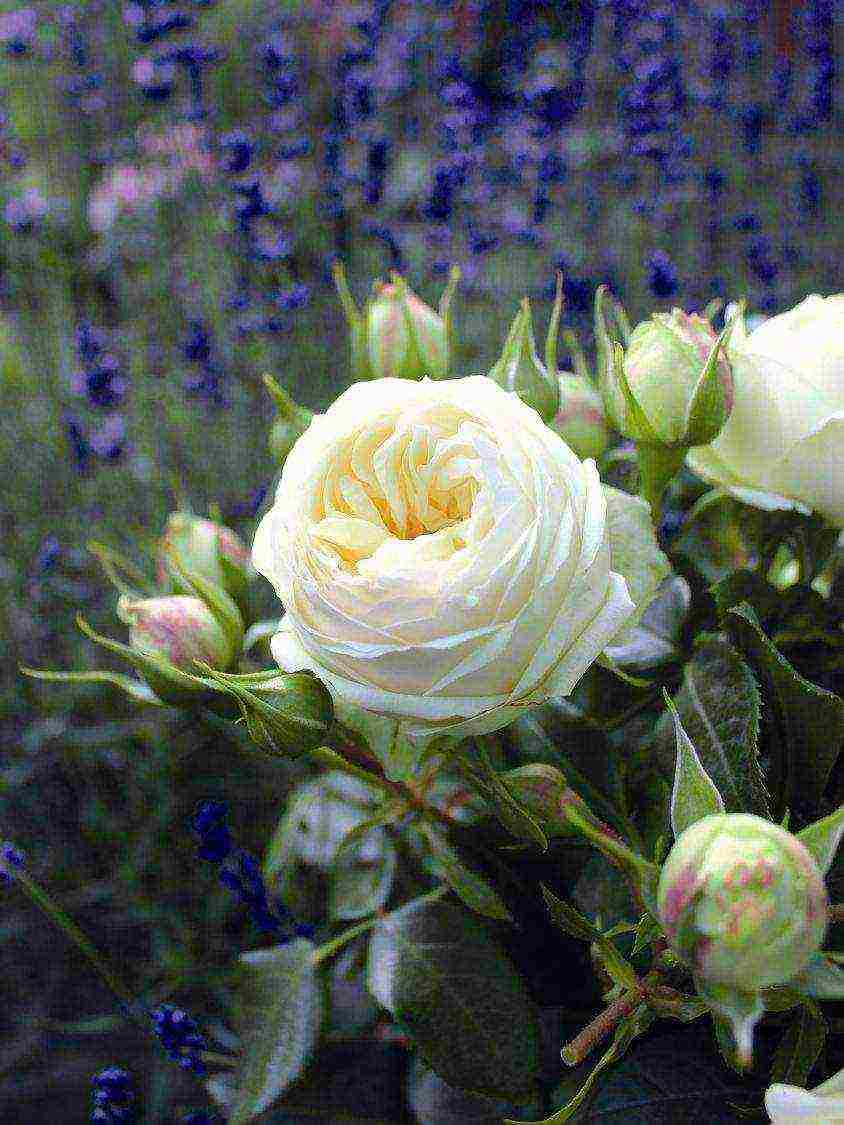
Variety Wading Piano brought out in 2013 in Germany (Rosen - Tantau). Narrow bushes (from 0.45 to 0.6 m) reach a height of 1 to 1.2 meters. White-cream flowers of an old spherical shape with a pleasant mild aroma consist of 40 petals. Their width reaches 6-7 cm. Slow opening and high resistance to precipitation attracts attention. Flowering can be repeated several times.
Variety Wedding The piano stands out for its good resistance to the main diseases of roses.
Garden crops such as spray roses amaze the observer with their incredible beauty. These short, compact plants have appeared relatively recently, but quickly gained popularity among gardeners.
The best varieties of rose spray
The constantly increasing demand for spray has led to the fact that more and more varieties began to appear in the world selection every year. Next, let's take a look at the description of the most common varieties.
Lydia
It is considered the ancestor of many cultures. The variety was bred by Dutch breeders at the end of the last century. The plant is distinguished by a spreading bush up to 70 centimeters in height, flowers up to 4 centimeters in diameter with pink petals.

Rose Mimi Eden
It differs from the rest in beautiful white inflorescences with a pink tint. In the stage of formation, the buds are apricot, when blooming they turn pink. The initial color of the petals changes to white upon prolonged exposure to sunlight.
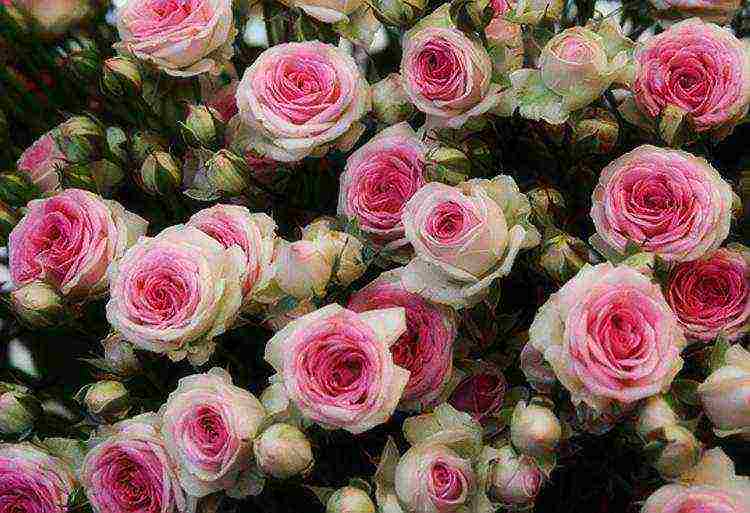
Tamango
The bush of a compact decorative rose Tamango reaches a height of 50 centimeters. The buds of this culture, up to 7 centimeters in diameter, consist of numerous densely double scarlet petals. Each branch can simultaneously accommodate up to 12 peduncles. A feature of the variety is considered to be high winter hardiness.
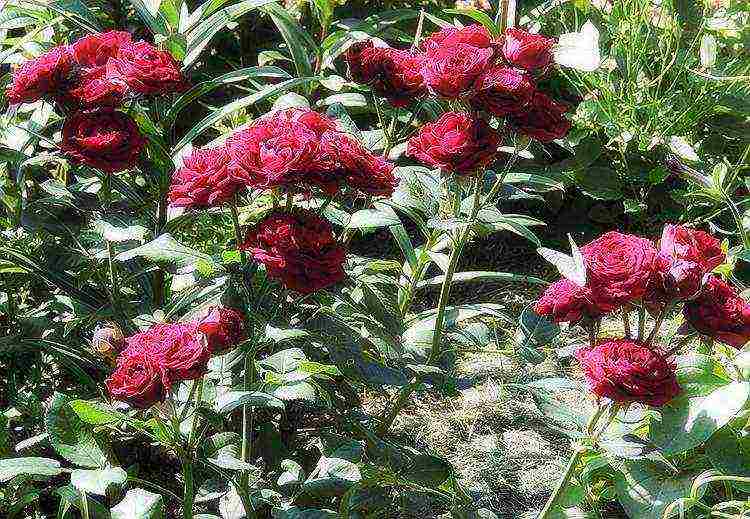
Tiramisu
The Dutch Tiramisu rose has two-color buds. The height of the plant bush does not exceed 50 centimeters. Flowers are small, 12-15 per cluster.The outer side of the petals is terracotta, the outer side is cream.

Orange
The orange variety lives up to its name, as it has bright orange petals. The buds resemble a tea rose in appearance, their diameter does not exceed 4 centimeters.

Rubicon
Roses spray Rubicon have large, goblet purple buds. These flowers create a light, sophisticated scent.

Typhoon
Terry rose Typhoon has orange-red petals, which turn yellow closer to the middle.

All varieties of spray roses are often used to create wedding bouquets.
Site selection and soil preparation
Cultivation of crops can be carried out by both beginners and experienced gardeners, the main thing is to observe all the nuances of growing. To plant a plant in the garden, you need to choose a sunny, but protected from the winds area.
It is advisable to plant varieties with light petals in sunny areas, and roses with dark inflorescences are recommended to be placed in partial shade. If this is not done, then with high solar activity, the intense color of plant buds will soon become light.
It can take up to three months to prepare high-quality soil for flowers, so for planting plants in the fall, the soil must be prepared in summer or in October if planting is planned for the spring.
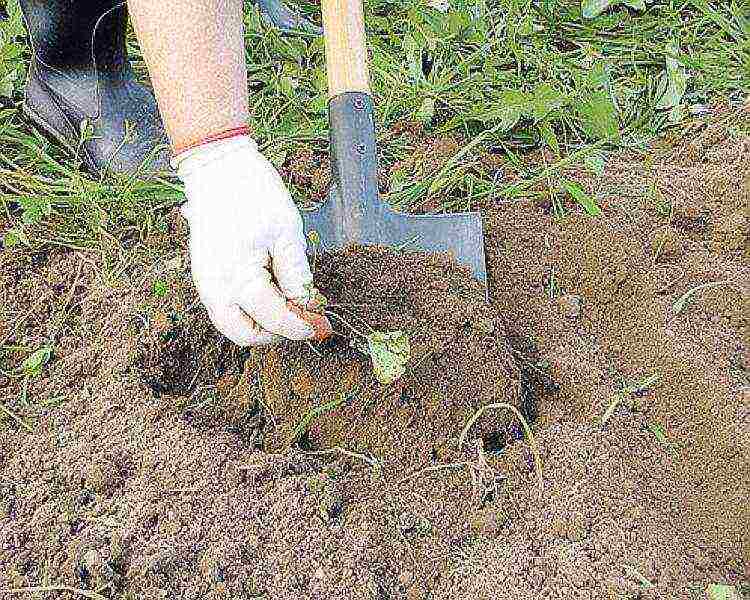
The basic rules for soil preparation are as follows:
- We remove weeds and their rhizomes from the site.
- We dig up the soil on the bayonet of the shovel with the simultaneous transshipment of the earth. Next, a ditch is made 40-50 centimeters deep and the top soil with fertilizers is poured onto the bottom, and then the bottom layer is mixed with fertilizers. For several months of vystoyka, the earth in the ditch subsides and is saturated with useful substances. Along with this, excess moisture also leaves.
- Some growers immediately plant the plants in pre-dug soil with dug depressions, but this method is considered less effective.
In the case of planting plants in pre-prepared, transshipped soil, the root system will develop rapidly and gain unhindered access to oxygen.
Many gardeners do things differently. They dig up the area on a shovel bayonet without prior leveling in the fall. This will contribute to the freezing of the top layer of the soil and the destruction of pathogenic bacteria and microorganisms harmful to roses, pest larvae. Fertilizers added during this period will be able to dissolve over the winter.
With the arrival of spring, the planting site is leveled with a metal rake and holes begin to be dug for planting crops. The depth and width of such depressions should be 25-30 centimeters higher and wider than the root system of the plant. Subject to these parameters, the pit is filled with light nutritious soil, which will give an impetus to the intensive development of the root system.

During the preparation of the soil for the rose garden, the influence of predecessors must be taken into account. It is known that roses grow poorly in areas where cinquefoil, cherry, quince or hawthorn were previously located. In such areas, a 50 cm layer of soil is removed and replaced with new soil.
The acidic composition of the soil can be determined by litmus test. So red indicates an acidic earth, blue indicates a neutral acidic soil. Sorrel and horsetail usually grow on acidic soil, clover or horseradish on alkaline soil. In the presence of alkaline soil, superphosphate or compost, needles are added to its composition. Wood ash or bone meal is added to acidic soil.
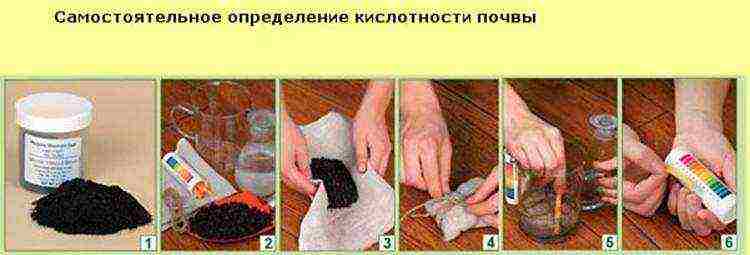
How to choose the right seedlings
Rose planting material can be sold in mini containers or in bags filled with nutrient substrate, less often open. When planting in the fall, it is better to choose seedlings with an open root system, but plants in containers are better suited for planting in the spring.
Before purchasing, carefully inspect the bush and its root system for damage and other defects such as mold and dried out areas.In the case of purchasing plants in a package, pay special attention to the condition of the soil, it must be crumbly, not have a specific smell. A strong, healthy seedling with white roots at the bottom is the best choice.
The successful alignment of the scion with the stock is indicated by an even callus at the grafting site.
Preparing seedlings for planting
Before planting, the stems of rose seedlings must be pruned. Together with this, buds, damaged and dried branches are removed. On the main shoots of the bush, 4 ... 5 eyes are left. less developed stems should contain at least 3 buds. It is also necessary to lightly trim the lateral roots and remove the damaged ones.
For disinfection and speedy healing, gently coat all cut sites with garden varnish.
After carrying out these operations, plants with open roots are placed for 12 hours in a solution of water and sodium humate. To prevent drying, the roots of the seedlings are dipped in a mash, which is made of clay, water and a root formation stimulator, the components are mixed until a creamy consistency. After that, the root system is carefully wrapped in moistened burlap.
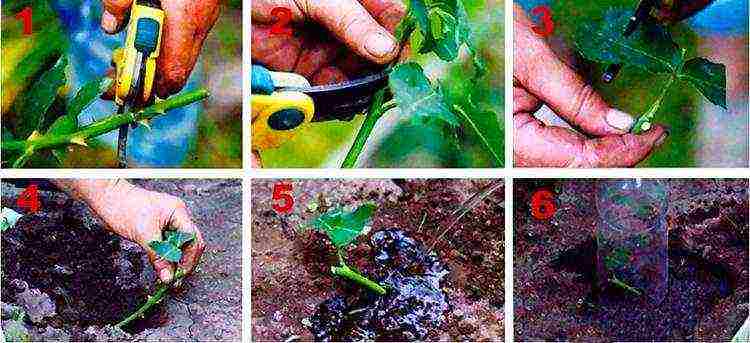
Landing
Spray planting can be done by both an experienced gardener and an amateur. The entire workflow can be roughly divided into several stages:
- we dig a landing hole with a depth and width of 45-50 centimeters;
- we fill in the drainage in the form of small pebbles and coarse sand at the bottom of the ditch;
- scatter organic matter (compost and humus);
- sprinkle nutrients with a thin layer of earth;
- gently straighten the roots, place the seedling in the hole and sprinkle it with earth.
After carrying out such actions, we water the rose with warm water. For each bush, you need to use 6-8 liters of liquid.
Growing
Further care for roses is a simple spray. All that is required is to loosen the aisles in time and remove weeds, as well as water and fertilize, cut off shoots on lush bushes. Next, we will deal with all the activities in more detail.
Watering and feeding
Plants need regular abundant watering throughout the growing season, and especially during flowering in persistent drought. Laying mulch in the root zone of the plant will help to simplify the process. A thick layer of sawdust or low-lying peat will prevent moisture from evaporating.

In the absence of a mulching layer, the soil must be constantly loosened and weeds removed. In hot weather, burns can appear on the leaves of roses. To prevent this phenomenon, the bushes are watered with warm water in the evening by sprinkling.
For long-term intensive flowering, spray roses must receive additional nutrients, which are introduced into the soil in the form of dressings.
At the initial stage of development, nitrogen is required before the first buds appear. Flowering shrubs take from the soil a significant amount of phosphorus and potash fertilizers, as well as trace elements.
Correctly cut and form a bush
Not only old, but also young bushes are formed. After pruning in the fall, strong lignified branches with buds should remain on the plant. Old and shrunken shoots, as well as wind-damaged shoots, are not left on the plants. During the pruning of roses, the following rules must be observed:
- use a previously disinfected sharp pruner or other tool for work;
- pruning is carried out from the bottom to the top of the bush;
- the sections are carried out over the external kidney at an angle of 45 degrees;
- if the plant can be damaged by diseases and pests, the wounds are covered with garden var.

The technology for forming a bush depends on the variety of culture. So short pruning is used for highly bushy plants. With an average formation, the bush is shortened by half the length, leaving 30 centimeter stems with 5 ... 6 buds.Long pruning involves removing 2/3 of the branch, helping to achieve early flowering.
Similar work is carried out in the fall in the evening in the presence of warm weather. During formation, the 5 most developed shoots are determined on the bush, the rest are removed at the root.
A healthy shoot does not have a large number of lateral branches, has a dark green bark, and has a diameter of at least 1 centimeter.
On the selected stems, five buds are counted from below and an even cut of wood is made. During the work, make sure that the upper kidney remains on the outside. A distance of 1 centimeter recedes from it and an oblique cut is made towards the middle of the bush. After cutting the wound, the plants are covered with garden pitch and the branches are removed.
Preparing for winter
For normal wintering, it is necessary to make a hill of earth above the shoots of plants. Before hilling, remove non-lignified shoots, flowers and leaves. Experienced gardeners cut off all flowers and buds from roses in the last decade of October. This will help to harden the plants and prevent the use of additional nutrients from the soil. Sand or dry soil is poured over the stems of roses to a height of 35 centimeters. Further, the hill is covered with sawdust, low-lying peat or spruce branches.
Do not take the soil from the rows of flowers, such actions can provoke damage to the root system of plants.
There is another method of covering roses for the winter, air-dry. It consists in the device of an impromptu frame made of metal wire up to 50 centimeters high. Further, this structure is furnished with foam rubber, foam sheets or reeds. Next, a plastic wrap is stretched onto the frame, which will protect the plant from moisture penetration. To prevent the destruction of the material, the hanging pieces of the film are sprinkled with earth. An improvised shelter can be ventilated before the onset of cold weather with temperatures below -15 degrees.

How can you multiply
In practice, several spray rose propagation methods are used:
- Using seed. A time consuming method that involves the collection and stratification of grains, growing seedlings.
- Rooting of roses by layering is carried out in the spring. With this method of reproduction, one of the lashes is bent from the mother bush and covered with earth. By the fall, this shoot will have its own roots, after which it can be transplanted to a new place, as a separate plant.
- With the help of root suckers. Such plants are separated from the mother bush one year after emergence, when they have their own root system.
- By cuttings. In the middle part of the shoot, several pieces of the stem are cut and placed in a solution of water and a growth stimulant. In the future, the plant is rooted in a special greenhouse, a school under a certain temperature and humidity regime.
- In the case of dividing the bush, the rose is cut into pieces. Moreover, each plot must have its own root system and 2 ... 3 developed buds.
The fastest way to reproduce is to divide the bush. In this case, spray roses retain varietal characteristics. The use of seed is practiced by breeders to obtain new types of crops.
Pest and disease control
Aphid
The main pest of roses is aphid spray. These small insects settle in colonies on the inside of the crop leaves. The parasites suck the sap from the plants, which leads to wilting and twisting of the leaf plates. Aphids multiply intensively, giving up to 10 generations per year.
The presence of aphids on plants can be unmistakably identified by damaged leaves or chaotically moving ants (they feed on parasite sap).
To effectively combat the pest, a soap solution with the addition of mustard powder or chemical preparations Karbofos, Aktelik, Rogor is used.

Cicadca
Another dangerous rosary pest is the leafhopper.After parasitizing this insect, the leaves of the flower become covered with white spots, losing their original appearance. With severe damage, yellow spots appear on the surface. To combat the parasite, chemicals and insecticides are used.
The pale yellow or white leafhopper with an elongated body does not pose a danger to the plant. The main harm is caused by insect larvae, which feed on plant juices.

Spider mite
The spider mite is especially harmful to the culture. Its oval body, up to 0.5 millimeters long, consists of 4 pairs of legs. The color of the body is red or orange, the larvae are greenish. Parasites damage the lower surface of the leaves of roses, suck out juices, which leads to the appearance of yellow spots and a loss of decorativeness of the plant.
You can detect the pest with a magnifying glass or by the thin cobwebs that bind the leaves.
Tick colonies can be destroyed with chemicals such as Vermithek or Fitoverm.

Leaf roll
Of the pests of the rose, special attention should be paid to the leaflet. Caterpillars appear on the plant in early spring, begin to gnaw the buds and young shoots, then take up the leaves. Caterpillars are harvested by hand and destroyed, with strong foci of damage, the plant is treated with insecticides.
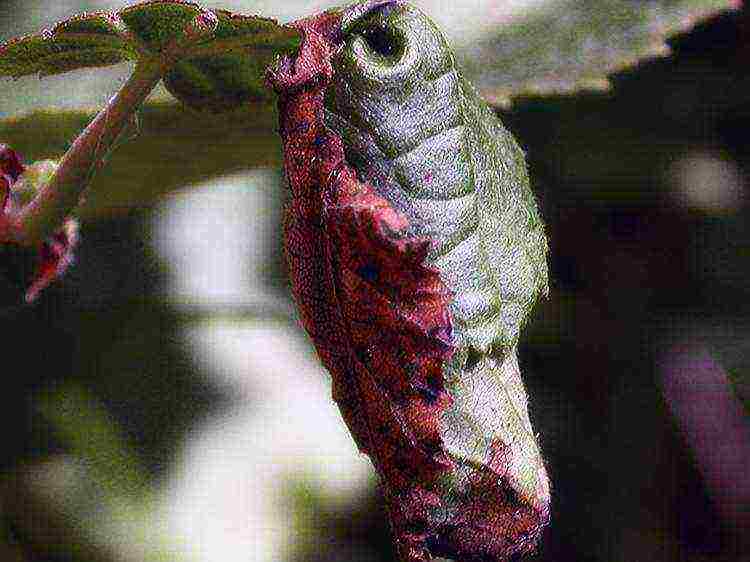
Powdery mildew
Powdery mildew is considered the most popular among rose diseases. The disease manifests itself in the form of a powdery white coating on the leaves and shoots of the culture.
Moderate temperature and high humidity can be the cause of its occurrence.
Powdery mildew is prevented by spraying plants with a Bordeaux mixture and applying phosphorus-potassium fertilizers. At an intensive rate of development of the disease, roses are sprayed with a solution of soda ash 0.5% concentration.
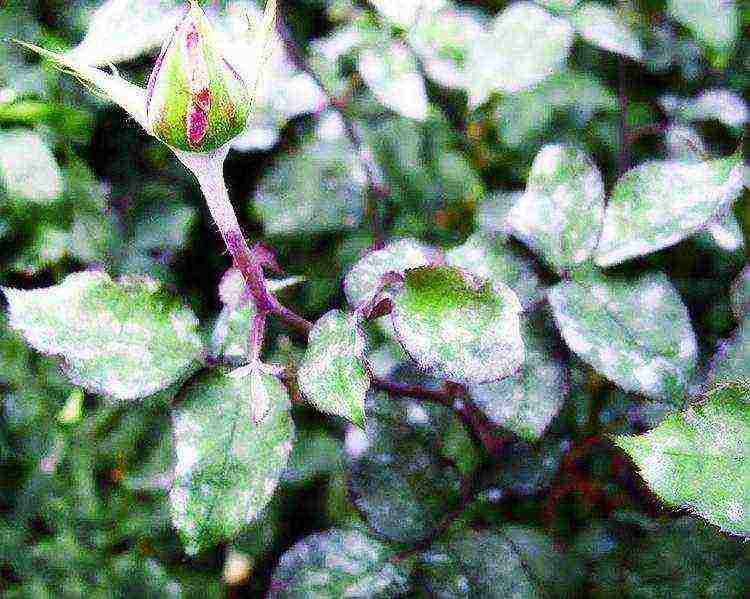
Black spot
This is a fungal disease that appears on the leaf blades of the rose in the form of brown spots from the middle of summer. Severe damage leads to complete blackening, drying out and leaf fall. Fungal spores hibernate in fallen leaves and shoots, which is why organic remains must be removed from the site and burned.

Another effective solution to the problem is the spring treatment of rose leaves with Bordeaux liquid.
Even a novice gardener can handle growing roses with spray. The main thing in this matter is to follow the rules of planting and caring for plants, to carry out timely processing of flowers from diseases and pests.

